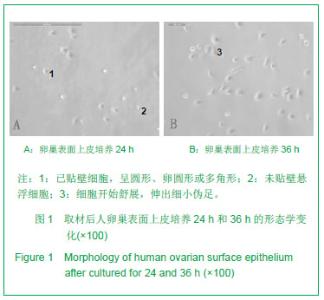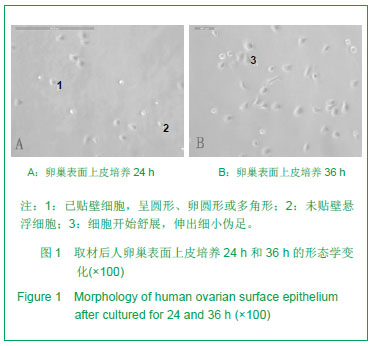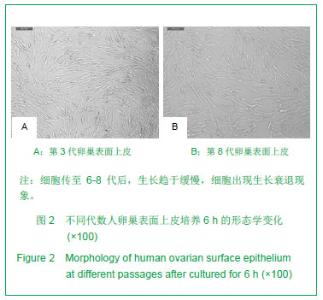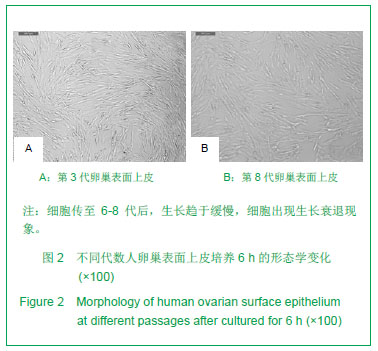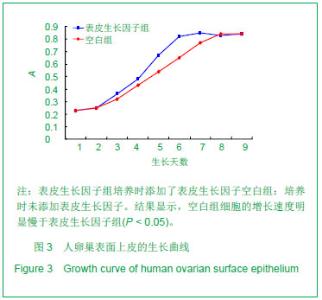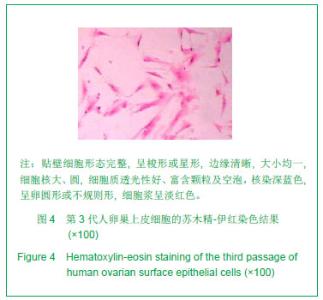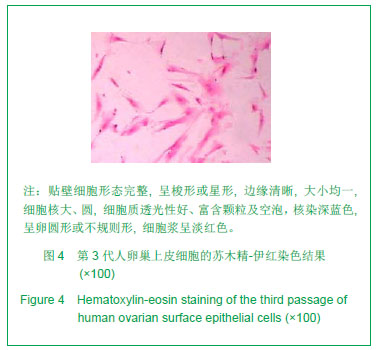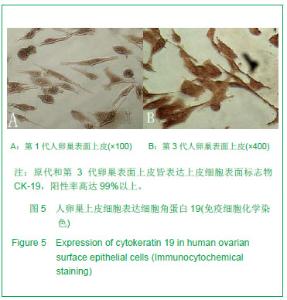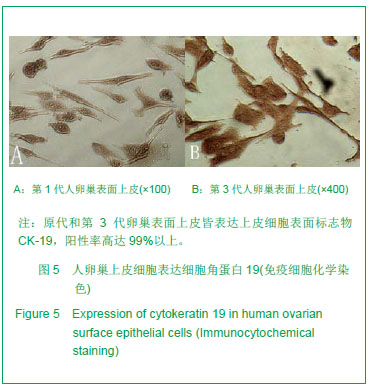| [1]Machelon V, Gaudin F, Camilleri S, et al. CXCL12 expression by healthy and malignant ovarian epithelial cells. BMC Cancer. 2011;11: 97.[2]Brown TJ, Shathasivam P. Maintaining mesenchymal properties of ovarian surface epithelial cells: a potential early protective role for TGF-beta in ovarian carcinogenesis. Endocrinology. 2010;151(11):5092-5094.[3]Miyamoto M, Takano M, Goto T. Clear cell histology as a poor prognostic factor for advanced epithelial ovarian cancer: a single institutional case series through central pathologic review.J Gynecil Oncol. 2013;24(1):37-43.[4]Kwong J, Chan FL, Wong KK, et al. Inflammatory Cytokine Tumor Necrosis Factor alpha Confers Precancerous Phenotype in an Organoid Model of Normal Human Ovarian Surface Epithelial Cells. Neoplasia. 2009;11:529-541.[5]Virant-Klun I, Skutella T, Stimpfel M, et al. Ovarian surface epithelium in patients with severeovarian infertility: a potential source of cells expressing markers of pluripotent/multipotent stem cells. J Biomed Biotechnol. 2011;2011:381928.[6]Vera C, Tapia V, Kohan K. Nerve growth factor induces the expression of chaperone protein calreticulin in human epithelial ovarian cells. Hurm Metab Res. 2012;44(8): 639-643.[7]Königs M, Mulac D, Schwerdt G, et al. Metabolism and cytotoxic effects of T-2 toxin and its metabolites on human cells in primary culture. Toxicology. 2009;258:106-115.[8]孙丽,于丽,张华芳, 等. 人脐带间充质干细胞的分离培养及生物学特性[J]. 解剖科学进展,2011, 17(2):131-134.[9]Hsiao FS, Cheng CC, Peng SY, et al. Isolation of therapeutically functional mouse bone marrow mesenchymal stem cells within 3 h by an effective single-step plastic-adherent method. Cell Prolif. 2010;43(3):235-248.[10]黄洁, 刘焰, 沈晓璐. 组织块培养法及酶消化法培养人角膜缘上皮细胞[J]. 眼科研究,2010, 28(1):22-24.[11]Qin Y, Zhao J, Su W, et al. Experimental study on culturing Schwann cells of rats by single-enzyme digestion and explant-culture method. Zhongguo Xiu FU Chong Jian Ke Za Zhi. 2012;16(9):1107-1111.[12]丁维进, 唐乙, 宋艳玲. 应用改良差速贴壁法和有限稀释技术分离培养小鼠来源肌源干细胞[J]. 中国组织工程研究与临床康复, 2011,15(36):6797-6801.[13]孙浩林, 李淳德. 原代培养差速贴壁法分离纯化大鼠腰椎间盘髓核细胞[J]. 中国组织工程研究与临床康复, 2011, 15(46): 8569-8573.[14]Ellerström C, Hyllner J, Strehl R. Single cell enzymatic dissociation of human embryonic stem cells: a straightforward, robust, and standardized culture method. Methods Mol Biol. 2010;584:121-134.[15]Ouchi NB. Growth curve analysis of tumourigenesis using cellular level cancer model. Radiat Prot Dosimetry. 2011; 143(2-4):365-369.[16]Morillo SM, Abanto EP, Roman MJ, et al. Nerve growth factor-induced cell cycle reentyr in newborn neurons is triggered by p38MAPK-dependent E2F4 phosphorylation. Mol Cell Biol. 2012;32(14):2722-2737.[17]Tzur A, Kafri R, LeBleu VS. Cell growth and size homeostasis in proliferating animal cells. Science. 2009;325(5937): 167-171.[18]姚德生,李力.永生化正常小鼠卵巢上皮细胞系的建立[J].广西医科大学学报, 2006,23(4):588-589.[19]Hudson LG, Zeineldin R, Silberberg M, et al. Activated Epidermal Growth Factor Receptor in Ovarian Cancer. Ovarian Cancer .2009;149:203-226.[20]崔凤梅,苏世标,聂继华, 等.大鼠气管-支气管上皮细胞的提取方法[J].毒理学杂志, 2005,19(:3):197-198.[21]袁毅君,巨玉萍,邢明哲, 等.动物细胞原代培养中常见微生物污染及对策[J].天水师范学院学报,2009,29(2):35-39.[22]Uphoff CC, Denkmann SA, Drexler HG. Treatment of Mycoplasma Contamination in Cell Cultures with Plasmocin. J BioMed Biotechnol. 2012;2012:267678.[23]Meirow D, Hardan I, Dor J, et al. Searching for evidence of disease and malignant cell contamination in ovarian tissue stored from hematologic cancer patients. Hum. Repord. 2008; 23(5):1007-1013.[24]王鸿, 张伟, 孟娜. 细胞培养中珍贵贴壁细胞污染挽救方法的评价[J]. 首都医科大学学报, 2011, 32(1):129-134.[25]周丽微.细胞培养技术与防止细胞污染的方法[J].医学信息,2011, 23(11):4387-4388. [26]候士方,孟馨,相泓冰,等.大鼠骨骼肌细胞的原代培养及鉴定[J].实验室研究与探索,2011,30(4):26-28. [27]高元妹, 张平, 夏旸, 等. 人支气管上皮细胞原代培养方法的对比研究[J]. 实用医学杂志,2011,27(15):2698-2700.[28]祁燕,李燕舞,王汝俊,等. 大鼠结肠上皮细胞分离及培养方法的建立[J]. 世界华人消化杂志,2012,20(22):2030-2035.[29]李辰运,陈剑秋,孙晋津,等. 差速贴壁法培养大鼠骨髓内皮祖细胞的实验研究[J]. 天津医药,2011, 39(4): 353-356.[30]Telfer EE, McLaughlin M, Ding C,et al. A two-step serum-free culture system supports development of human oocytes from primordial follicles in the presence of activin. Hum Reprod. 2008;23(5):1151-1158.[31]Hinterhuber G, Marquardt Y, Diem E,et al. Oeranotypic keratinocyte coculture using normol human serum :an imminocorphological study at high and electron microscopic levels. Exp Dermatol. 2002;11(5):413-420.[32]Labsky J,Dvorankova B,Smetana K, et al. Mannosides as Crucial part of bioactive supports for cultivation of human epidermal keratinocytes without feeder cells. Biomaterials. 2003;24(5):863-872.[33]Niknejad H, Peirovi H, Ahmadiani A, et al. Differentiation factors that influence neuronal markers expression in vitro from human amniotic epithelial cells. Eur Cells Mater. 2010;19: 22-29. [34]刘莹,李亚辉. 卵巢表皮上皮的生物学特性及其细胞培养[J].中国畜牧兽医,2012, 9(12):133-136.[35]De Carlo F, Ledda M, Pozzi D. Nonionizing radiation as a noninvasive strategy in regenerative medicine: the effect of Ca(2+)-ICR on mouse skeletal muscle cell growth and differentiation. Tissue Eng Part A. 2012;18(21-22):2248-2258.[36]Gron B, Stohze K, Andersson A, et al. Oral fibroblasts produce More HGF and KGF than skin fibroblasts in response to co-culture with keratinocytes. APMIS. 2002;110(12): 892-898.[37]李政.角朊细胞培养技术最新进展[J].国外医学:生物医学工程分册, 2003,26(4):184-187.[38]Mataraci EA,Ozguven BY,Kabukcuoglu F. Expression of cytokeratin 19, HBME-1 and galectin-3 in neoplastic and nonneoplastic thyroid lesions. Pol J Pathol. 2012;63(1):58-64.[39]Abbas O, Richards JE, Yaar R, et al. Stem cell markers (cytokeratin 15, cytokeratin 19 and p63) in in situ and invasive cutaneous epithelial lesions. Modem Pathalogy. 2011;24: 90-97. |
